Status of Deliberation in the Diet
|
| Resolution
for the Relocation of the Diet and Other Organizations
Adopted |
|
The Special Committee for the Relocation of the Diet
and Other Organizations committed to adopted a resolution
for the relocation of the Diet and other organizations.
The committee hopes to select a candidate relocation site
based on the report of the Council for the Relocation
of the Diet and Other Organizations and to initiate the
necessary study immediately so as to reach a conclusion
in two years. |
|
|
|
Resolution for the Relocation of the Diet and
Other Organizations
(by the Special Committee for the Relocation
of the Diet and other Organizations of the House of Representatives
on May 18, 2000) |
|
The prime minister presented the
report of the Council to the Diet about in December
1999. The Diet is requested to react seriously
to the report and study Japan's future from a
broad point of view to reach an appropriate conclusion
beyond criticism in Japan and overseas.
The relocation of the Diet and other organizations
will significantly impact Japan's future. It is
therefore a very important issue that affects
state politics, as well as a great historical
project to be conceived from a long-term extending
over a century.
In the special committee meeting, the government
declared that it expects the Diet to reach an
early conclusion on the relocation of the Diet
and other organizations and would cooperate with
the Diet toward that end.
Responding to these expectations, an important
task imposed on the Diet is to select one of the
present three candidate relocation sites for the
Diet and other organizations and then study the
relocation in compliance with the Law for the
Relocation of the Diet and Other Organizations
through comparison with Tokyo Metropolis, considering
various social and economic conditions.
Be it resolved that the Special Committee should
immediately promote the study by selecting a candidate
relocation site based on the Council report, obtaining
cooperation from the government and related persons,
and taking listening to the opinions from a wide
range of people. |
|
|
|
|
|
Field Inspection Conducted |
|
The Special Committee for the Relocation
of the Diet and Other Organizations of the House of Councilors
conducted a field inspection in the Gifu-Aichi Region
on May 22. Local public bodies outlined the project situation
for the inspection team and others. The team then conducted
an on-site inspection, designating the Tono Earth Science
Center, Cera-Techno Toki and Toyota West Hirose Industrial
Zone as the main inspection points. |
|
|
Status of Capital Relocation in Germany |
| In Germany, the capital relocation
from Bonn, the former capital
of West Germany, to Berlin was
decided on the unification of
the country, and full operations
were started in Berlin in September
1999. |
|
|
|
|
|
| Details of
Capital Relocation in Germany |
| August 1990 |
Both East and West German governments
signed the German Unification Treaty (Designation
of Berlin as the capital was declared) |
| June 1991 |
Capital relocation to Berlin was resolved
by the Federal Parliament (337 yeas and
320 nays) |
| August 1999 |
The Chancellor was installed and the
Federal Parliament meeting was held in
Berlin |
|
|
| The Look of the
New Parliament Assembly Hall |
|
The former Imperial Parliament
Assembly Hall has been thoroughly
renovated to keep pace with the
time while conserving its external
appearances. There is a spiral
staircase made from glass and
steel inside of the hall, and
the new assembly hall and the
urban area can be seen from there. |
|
|
|
| Externa Appearance |
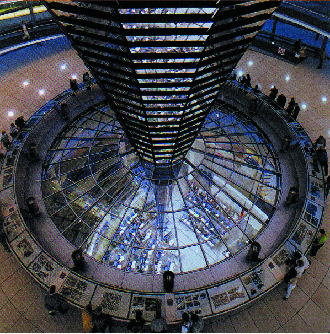 |
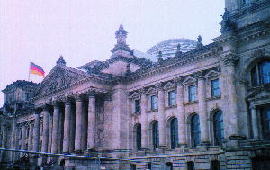 |
| Interior |
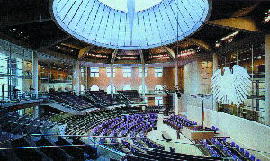 |
|
|
|
|
Administrative Government Offices |
|
Principles concerning the relocation were stipulated
by the Berlin and Bonn Law. Administrative offices
such as the Official Residence of the Federal
President, the Federal Prime Minister's Office,
the Federal Information and Public Relations Agency,
the Ministry of Foreign Affairs, and the Ministry
of Internal Affairs have already been relocated
to Berlin. Administrative Offices such as the
Ministry of Defense, the Ministry of Education
and Science, and the Ministry of Environments
will not be relocated to Berlin but will stay
behind in Bonn. |
|
|
|
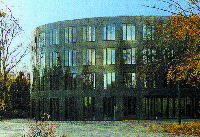 |
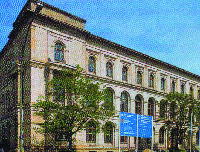 |
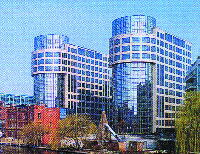 |
| Official Residence
of the Federal President |
Ministry of Transportation,
Construction and Housing |
Ministry of Internal
Affairs |
|
|
|
| Improvement
and Development of the Urban Functions of Berlin |
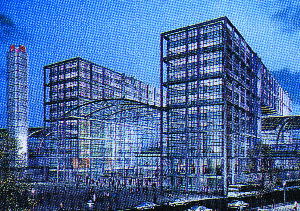 |
High-speed traffic networks to
connect areas all over Europe are being planned
with Berlin at the core. A new rail station will
be constructed near the new Federal Prime Minister's
Office by 2003. In parallel with the city construction,
upgrading of traffic, energy and environmental
and information communication technologies are
being upgraded. An optical fiber network with
a total length of 62 thousand km long will be
the largest one in Europe, and a most up-to-date
research technology park will be constructed by
2010.
Cultural facilities are also being constructed,
including three large opera theaters, 167 museums,
and 150 stages. |
| Image of the New Railtor
Station |
|
The German
Embassy Homepage "New Berlin"
was referred to in writing this article.
We also recommend you to utilize this
Homepage.
ihttp://www.germanembassy-japan.org/japanisch/archiv/berlin.htmj |
|
| Comment
by a Learned Man: About
the Relocation to Berlin |
|
by Assistant
Professor Yuichi Morii
(Specialized in International
Political Science/German
Politics) of
the Graduate School of
Arts and Sciences, University
of Tokyo |
|
|
|
When the German Federal Parliament
resolved to relocate most part
of the capital functions from
Bonn to Berlin, there were 337
ayes to 320 noes. Although there
were various political opinions
behind that narrow margin, the
capital function relocation from
Bonn, a small city along the Rhine,
to Berlin was a manifestation
of the strong political will to
complete the German unification.
Bonn has been a symbol of the
political system called Federal
Republic (West Germany), characterized
by democracy, peace and European
unification, as well as a federal
system for forty years. When the
cold war ended and German unification
was achieved, a new Federal Parliament
Assembly Hall was under construction,
and it was not so inconvenient
to leave the capital functions
in Bonn.
Implementing the capital functions
relocation to Berlin in spite
of this situation was clearly
based on a strong political will
to protect the west Berlin, a
stronghold of freedom during the
dark days of modern Germany symbolized
by the Nazis control, West Germany
under divisional occupation, and
the Wall of Berlin. Capital relocation
to Berlin was to manifest Germany's
resolution to overcome 45-year
divisional occupation to promote
unity and harmony.
Germany is a federation of states,
as clearly stated in its name.
Therefore, its capital functions
are dispersed by nature. There
was an anxiety about relocating
the capital to the large city
of Berlin, which may suggest a
centralized nation. Therefore,
many of the government buildings
in Berlin have an open design
to formally reflect the citizen-oriented
politics fostered in Bonn despite
many restrictions, and environmental
considerations were also fairly
improved. Ten years after the
German unification, redevelopment
of Berlin and the capital functions
relocation progressed fairly satisfactorily.
The new capital is taking shape
from conditions, growing out of
the status like a gigantic construction
site. During this period, the
German politics played incessantly
stable and important roles in
the framework of the European
Unification represented by European
Union (EU). It has been relied
on by the neighboring countries
to wipe out anxiety about the
capital function relocation to
Berlin. |
|
|
|
|
| TOPIC |
Capital Functions Relocation Studied at
Various Schools |
|
|
|
Odawara
Municipal Shiroyama Junior High School |
|
| First-year students
of the Odawara Municipal Shiroyama
Junior High School visited the
National Land Agency (NLA) on
April 27 to deepen their understanding
about the capital functions relocation.
In the hour of questions and answers,
frank and lively opinions were
exchanged. An NLA official asked,
"What kind of city do you
want to live in?" The answers
were "A city with nice environments"
or "A safe city." |
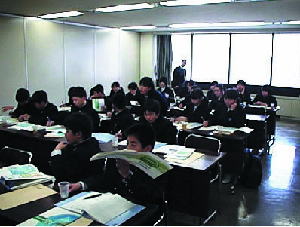 |
|
|
|
|
Keiogijuku
Yochisha (Primary School) |
|
| Six-year pupils
of the Keiogijuku Yochisha studied
the capital functions relocation
using the Capital Function Relocation
Experience CD-ROM. They high evaluated
the CD-ROM saying "Video
images are beautiful" and
"It's game-like and interesting." |
 |
|
|
|
|
Komaba
Junior High School Attached to the University
of Tsukuba |
|
| Four two-year students
of the Komaba Junior High School
Attached to the University of
Tsukuba visited the National Land
Agency to learn about the research
theme "The Capital Functions
Relocation" as part of their
off-campus study. They were well
prepared and actively exchanged
opinions with the NLA officials. |
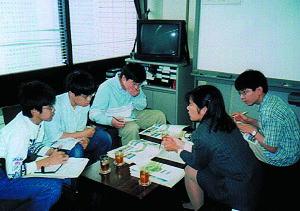 |
|
|
|
| Contributions
to the News Letter Invited |
|
This news letter will be
used to widely disseminate information
of your opinions or reports. Contribution
of articles, essays, and original drawings
are invited.
We would like to limit the contributions
to one A-4 size sheet due to the restricted
number of pages of this news letter. For
further rules for contribution, please
contact us at the address shown at the
end of this news letter.
We would hope you would apply willingly
for this invitation. We are awaiting your
opinions and others. |
|
|
Accessing Various Information |
| - |
Various information concerning the capital functions
relocation has been being provided on the National Land
Agency Homepage on the Internet.
Also if you are interested in items described in this
leaflet and others, please let us know. We will pleasingly
send related documents to you. We are awaiting your contact. |
|
|
| We are Waiting
for Your Contact |
| - |
Address: Capital Functions Relocation Planning Division,
Metropolitan Areas Development Bureau, National Land Agency
2-2 Kasumigaseki 1-Chome, Chiyoda-ku, Tokyo 100-9972 JAPAN
Homepage: http://www.mlit.go.jp/kokudokeikaku/iten/index.html
E-mail:hqt-itenka(a)gxb.mlit.go.jp (Please replace (a) with @)
|
|
|